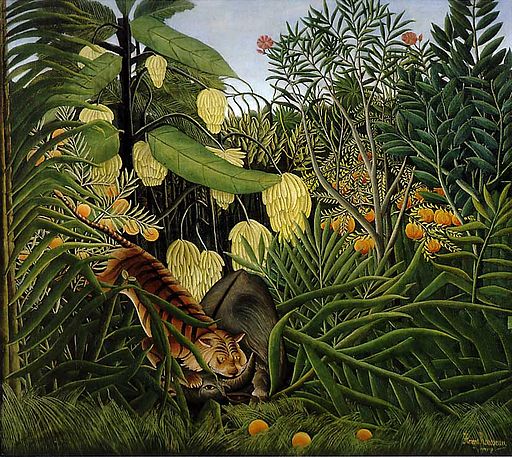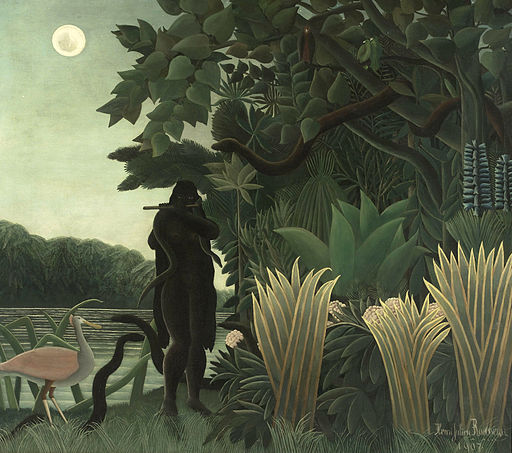
“Tropical Landscape: American Indian Struggling with a Gorilla” by Henri Rousseau
Henri Rousseau (1844 – 1910) was a French post-impressionist who painted in the Naïve or Primitive manner. He started painting seriously in his early forties; by age 49, he retired from his job to work on his art full-time.
Primitivism and Naïve Art by Henri Rousseau
- “Tropical Landscape: American Indian Struggling with a Gorilla” by Henri Rousseau – Virginia Museum of Fine Arts
- “Struggle between Tiger and Bull” by Henri Rousseau – Hermitage Museum
- “The Equatorial Jungle” by Henri Rousseau – National Gallery of Art, DC
- “Combat of a Tiger and a Buffalo” by Henri Rousseau – Cleveland Museum of Art
- “The Snake Charmer” by Henri Rousseau – Musée d’Orsay
- “Horse Attacked by a Jaguar” by Henri Rousseau – Pushkin Museum of Fine Arts
“Tropical Landscape: American Indian Struggling with a Gorilla” by Henri Rousseau
“Tropical Landscape: American Indian Struggling with a Gorilla” by Henri Rousseau is a dreamlike scene where imagination dictated the compositions rather than traditional forms of perspective and scale.
Rousseau studied exotic plants and animals in Paris’s botanical gardens and zoos, as he had never traveled outside of France.
Henri Rousseau was inspired by the romantic views of the American West promoted by magazine images of Native Americans and American Wild West Show that toured France.
“Tropical Landscape: American Indian Struggling with a Gorilla” by Henri Rousseau
- Title: Tropical Landscape: American Indian Struggling with a Gorilla
- Artist: Henri Rousseau
- Date: 1910
- Medium: Oil on canvas
- Dimensions: Height: 113.6 cm (44.7″); Width: 162.5 cm (63.9″)
- Museum: Virginia Museum of Fine Arts
~~~
“Struggle between Tiger and Bull” by Henri Rousseau

“Struggle between Tiger and Bull” by Henri Rousseau
“Struggle between Tiger and Bull” by Henri Rousseau depicts an idealized “primitive” fantasy of a tiger attacking a bull in a jungle setting.
This painting is similar to Rousseau’s other artworks depicting animals amongst foliage inspired by the artist’s study of Paris’ botanical gardens and the many jungle pictures he collected.
Rousseau also took inspiration and adapted the wild beasts from popular ethnographic journals.
Despite its apparent simplicity, Rousseau’s jungle painting was built up meticulously in layers, using a large number of green shades to capture the lush abundance of the jungle.
“Struggle between Tiger and Bull” by Henri Rousseau
- Title: Struggle between Tiger and Bull
- Français: Combat de tigre et de buffle
- Artist: Henri Rousseau
- Date: 1909
- Medium: Oil on canvas
- Dimensions: Height: 46 cm (18.1″); Width: 55 cm (21.6″)
- Museum: Hermitage Museum
~~~
“The Equatorial Jungle” by Henri Rousseau
“The Equatorial Jungle” by Henri Rousseau
“The Equatorial Jungle” by Henri Rousseau was ridiculed during much of his life as a naïve painting. Rousseau’s technique included the use of controlled brush strokes, which made each object in the painting appear outlined.
Eventually, with the endorsement of Picasso, Matisse, and other artists, Rousseau gained the recognition he craved. Today he is known a self-taught genius famous for his imaginary jungle scenes.
Primitivism is a mode of aesthetic idealization that aspires to recreate the “primitive” experience.
Henri Rousseau created several paintings of the jungle scenes that can be classed as Primitivism Art while working in a style that is also called Naïve Art.
Naïve Art is created by an artist who lacks formal education and training in art history, technique, and perspective.
“The Equatorial Jungle” by Henri Rousseau
- Title: The Equatorial Jungle
- Artist: Henri Rousseau
- Date: 1909
- Medium: Oil on canvas
- Dimensions: Height: 140.6 cm (55.3″); Width: 129.5 cm (50.9″)
- Museum: National Gallery of Art, DC
~~~
“Combat of a Tiger and a Buffalo” by Henri Rousseau

“Combat of a Tiger and a Buffalo” by Henri Rousseau
“Combat of a Tiger and a Buffalo” by Henri Rousseau is a highly stylized and unique depiction of simplified images of animals and nature painted in flat, bright colors.
Rousseau’s imaginative visions and the technique of painting was unique. He applied one layer at a time, creating multiple layers, and he carefully blended his brushstrokes to create a smooth surface.
Henri Rousseau’s inspiration came from illustrations in children’s books and botanical gardens as well as tableaux of wild taxidermy animals in Paris’s museums of Natural History.
Henri Rousseau frequently visited the Jardin des Plantes for inspiration. he is quoted as saying:
“When I go into the glasshouses, and I see the strange plants of exotic lands, it seems to me that I enter into a dream.”
The Jardin des Plantes (French for “Garden of the Plants”) is the central botanical garden in France. The Jardin des Plantes maintain a botanical school, with thousands of plants arranged by family on one hectare (10,000 m²) plot.
Three hectares are devoted to horticultural displays of decorative plants. An Alpine garden has species with worldwide representation.
Specialized buildings, such as the winter garden, and Mexican and Australian hothouses display regional plants, not native to France.
“Combat of a Tiger and a Buffalo” by Henri Rousseau
- Title: Combat of a Tiger and a Buffalo
- Artist: Henri Rousseau
- Date: 1908
- Medium: Oil on canvas
- Dimensions: 170 × 189.5 cm (66.9 × 74.6 ″)
- Museum: Cleveland Museum of Art
~~~
“The Snake Charmer” by Henri Rousseau

“The Snake Charmer” by Henri Rousseau
“The Snake Charmer” by Henri Rousseau depicts a woman with glowing eyes playing the flute in the moonlight by the edge of a dark jungle with a snake extending toward her from a nearby tree. The Musée d’Orsay described the painting as:
“a black Eve in a disquieting Garden of Eden.”
Henri Rousseau created a detailed depiction of the jungle back-lit by moonlight from a full moon. The snake, charmed by the music, stretches across the painting.
The Snake Charmer was Rousseau’s first significant commission and was exhibited in the 1907 Autumn Salon.
Rousseau had never traveled outside of France, but the exotic plants in the painting resulted from Rousseau’s visits to the Jardin des Plantes and magazines.
From 1922 to 1936, The Snake Charmer was in the collection of Jacques Doucet.
“The Snake Charmer” by Henri Rousseau
- Title: The Snake Charmer
- Français: La Charmeuse de serpents.
- Artist: Henri Rousseau
- Date: 1907
- Medium: Oil on canvas
- Dimensions: 169 × 189.5 cm (66.5 × 74.6 ″)
- Museum: Musée d’Orsay
~~~
“Horse Attacked by a Jaguar” by Henri Rousseau

“Horse Attacked by a Jaguar” by Henri Rousseau
“Horse Attacked by a Jaguar” by Henri Rousseau is jungle paintings depicting a Jaguar attacking a white horse painted with meticulous care. The horse stares transfixed in a strange contrast of white against lush green.
Rousseau’s fantastic scenes heralded Surrealism and were built up meticulously in layers, using a large number of green shades to capture the lush abundance of the jungle.
Rousseau’s work continued to be derided by the critics even after his death in 1910. Eventually, Henri Rousseau won a following among Picasso, Matisse, and Toulouse-Lautrec, who all became admirers of his work.
“Horse Attacked by a Jaguar” by Henri Rousseau
- Title: Horse Attacked by a Jaguar
- Français: Cheval attaqué par un jaguar
- Artist: Henri Rousseau
- Date: 1910
- Medium: Oil on canvas
- Dimensions: Height: 90 cm (35.4″); Width: 116 cm (45.6″)
- Museum: Pushkin Museum of Fine Arts
~~~
Primitivism
Primitivism in Art is an aesthetic idealization that aspires to recreate “primitive” experience. In Western Art, primitivism typically has borrowed from non-Western cultures perceived to be “primitive,” such as Paul Gauguin’s inclusion of Tahitian motifs in paintings and ceramics.
Borrowings from non-Western Art has been important to the development of Modern Art. Primitivism has also been critiqued for reproducing racist stereotypes.
The desire to be restored to a “state of nature” is as longstanding as civilization itself. In antiquity, the superiority of “primitive” life found expression in the so-called Myth of the Golden Age, depicted as the Pastoral.
Primitivism then gained new impetus with the European encounter of unknown peoples of the Americas, the Pacific, and Africa.
In the 19th century, global transportation brought the indigenous cultures of the European colonies and their artifacts into metropolitan centers.
Western-trained artists were fascinated by these objects, attributing their features and styles to “primitive” forms of expression.
These stylistic attributes, present in the visual arts of Africa, Oceania, and the Indians of the Americas, could also be found in the archaic and peasant Art of Europe and Asia, as well.
Naïve Art
Naïve Art is visual Art created by a person who lacks the formal training that a professional artist undergoes. When a trained artist emulates this aesthetic, the result is sometimes called primitivism or pseudo-naïve Art.
Naïve artists are aware of “fine art” conventions but are not skilled to use them or choose not to.
Naïve Art is recognized, and often imitated, for its simplicity and frankness. Paintings of this kind typically have a flat rendering with a rudimentary expression of perspective. Henri Rousseau was a particularly influential painter of “naïve art.”
The term Naïve Art is used for the forms of Fine Art, such as paintings and sculptures, but made by a self-taught artist, while objects with a practical use come under folk art.
Jungle Art by Henri Rousseau
- “The Hungry Lion Throws Itself on the Antelope” by Henri Rousseau – Beyeler Foundation
- “Negro Attacked by a Jaguar” by Henri Rousseau – Kunstmuseum Base
- The Sleeping Gypsy
- The Repast of the Lion
- Tiger in a Tropical Storm
- The Dream
Henri Rousseau
Henri Rousseau was self-taught and developed a style that lacked traditional training, with its absence of strict proportions, a one-point perspective, and with the use of sharp, often unnatural colors.
The result was art pieces that were imbued with a sense of mystery and eccentricity.
Rousseau started painting seriously in his early forties, and by age 49, he retired from his job to work on his art full-time. His primary employment before he retired was as the duty customs officer and tax collector.
Many critics who ridiculed his work disparaged Rousseau’s style. However, he always aspired, in vain, to common acceptance. Many observers commented that he painted like a child, but the work shows sophistication with his unique style and technique.
Ridiculed during his lifetime by critics, he came to be recognized as a self-taught genius whose work exerted an extensive influence on several generations of avant-garde artists.
Today, Henri Rousseau’s paintings are highly valued and prominent in the world’s leading art museums.
Henri Rousseau
- Name: Henri Julien Félix Rousseau
- Born: 1844 – Laval, Mayenne, France
- Died: 1910 (aged 66) – Paris, France
- Nationality: French
- Movement: Post-Impressionism, Naïve Art, Primitivism
- Notable works:
- The Customs Post
- The Sleeping Gypsy
- The Repast of the Lion
- Tiger in a Tropical Storm
- The Dream
- Primitivism and Naïve Art by Henri Rousseau
- Tropical Landscape: American Indian Struggling with a Gorilla
- Struggle between Tiger and Bull
- The Equatorial Jungle
- Combat of a Tiger and a Buffalo
- The Snake Charmer
- Horse Attacked by a Jaguar
10 Amazing Facts about Henri Rousseau
Why Is This Woman in the Jungle?
Henri Rousseau
~~~
“Beauty is the promise of happiness.”
– Henri Rousseau
~~~
Photo Credits: 1) Henri Rousseau [Public domain]
Popular this Week








 Sponsor your Favorite Page
Sponsor your Favorite Page SEARCH Search for: Search Follow UsJoin – The JOM Membership Program
Sponsor a Masterpiece with YOUR NAME CHOICE for $5
Share this:
- Tweet

